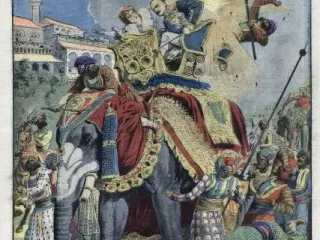The Moplah Rebellion, also known as the Malabar Rebellion, was a major uprising in the Malabar region of British India (present-day Kerala) in 1921. This complex and often controversial event involved Mappila Muslims, predominantly tenant farmers, against the zamindari system (landlord system) and British rule. While often simplified as a purely religious conflict, its causes were multifaceted and intertwined with socio-economic grievances and the broader context of Indian nationalism.
Causes of the Rebellion: The rebellion stemmed from deep-seated socio-economic inequalities. The Mappilas, largely agricultural laborers, faced severe exploitation under the prevailing zamindari system. High rents, arbitrary evictions, and the lack of land ownership rights fueled widespread resentment. This was further exacerbated by religious tensions and the prevailing political climate. The Khilafat Movement, a pan-Islamic movement advocating for the protection of the Ottoman Caliphate, added a significant religious dimension, mobilizing Mappila Muslims and influencing their actions.
Key Events: The rebellion began with sporadic protests and escalated into widespread violence. Mappila rebels seized control of several areas, establishing what were essentially independent republics, enforcing their own rule and often displaying extreme actions. The British responded with a brutal crackdown, employing significant military force to quell the rebellion. This led to considerable loss of life and widespread destruction. The rebellion witnessed both instances of communal violence between Hindus and Muslims, as well as instances of Mappilas targeting Hindus who were perceived as collaborators with the British or the zamindari system.
Key Figures: While no single leader orchestrated the entire rebellion, several prominent figures emerged during the course of the events. The leadership was largely decentralized, with local leaders and religious figures playing significant roles in mobilizing and directing the rebellion in different areas. Their motivations were complex and varied, reflecting the multiple grievances that fuelled the uprising.
Impact and Legacy: The Moplah Rebellion left a lasting impact on the Malabar region and the broader context of Indian history. It resulted in significant loss of life and widespread destruction, leaving behind deep-seated communal tensions. The British response was characterized by brutality, exacerbating the existing divisions. The rebellion's legacy remains a contentious issue, with differing interpretations of its causes and consequences. The event serves as a stark reminder of the complexities of land ownership, religious tensions, and the struggle for self-determination during India's struggle for independence. Historical analysis continues to debate the extent to which the rebellion was primarily a religious or socio-economic movement, or a combination of both.
Further Reading: A deeper understanding of this complex event requires consulting academic resources and historical accounts. These can offer a more nuanced and comprehensive perspective.












